Samsung offers two top models with a 4K resolution when it comes to MiniLED technology. In this test, we took a closer look at the not so "fancy" QN95D and QN90D, which we can also find under the name QN92D. Samsung proudly calls its MiniLED televisions the NeoQLED series. Thanks to this technology, the TV offers excellent contrast and high brightness, making movie watching an experience reminiscent of true cinema. During everyday use, the Tizen system performed excellently. It is fast, intuitive, and allows seamless switching between applications. We also appreciated how well the TV handles lower quality materials – traditional TV or older films looked better than we expected, and the advanced image processing algorithms did their job. This is a TV that can really enhance the viewing experience of content that isn't always in high resolution. The solar remote was a pleasant surprise for us. Although minimalist and with a small number of buttons, it turned out to be very practical – it allowed us to control not just the TV, but also other devices, like the decoder (Canal+) or soundbar. This meant we could reduce the number of remotes on the table, which immediately improved usability. Plus, solar charging – a simple idea that eliminates the need for battery replacements and aligns with eco-friendly trends. As for the picture in different conditions, the TV performs well in both bright and dark rooms. The high brightness and numerous dimming zones handle most content, although sometimes in contrasting scenes a halo effect is noticeable. The colours, however, are vibrant and natural, and the QLED coating gives them intensity. For even better results, we decided on calibration – after which the picture looked even more detailed and natural, which only confirmed our belief that QN92/QN90 is an excellent choice. And what about motion on the screen? It is absolutely fluid. The 144 Hz panel does an excellent job with dynamic scenes – fast actions, sports, games – everything looks natural and without blurring. We particularly appreciated the Auto Motion Plus Game feature, which makes games running at 30 frames look smoother, resembling 45 frames, and at 60 Hz, motion becomes even more natural, as if operating at 90 Hz. For gamers, this is a huge plus, especially since low input lag and features like the game bar further enhance the gaming experience. This is a TV that performs well in any situation – from evening screenings to gaming marathons. QN92D is a practical, well-designed TV that offers a picture quality that's really hard to ignore. An ideal choice for those looking for something more than just a regular screen for everyday content.
- Matching (Score)
- Our verdict
- TV appearance
- Where to buy
- Contrast and black detail
- HDR effect quality
- Factory color reproduction
- Color reproduction after calibration
- Smoothness of tonal transitions
- Image scaling and smoothness of tonal transitions
- Blur and motion smoothness
- Console compatibility and gaming features
- Input lag
- Compatibility with PC
- Viewing angles
- TV efficiency during daytime
- Details about the matrix
- TV features
- Apps
- Playing files from USB
- Sound
Samsung Neo QLED QN90D / QN92D vs Hisense E8Q
Direct compare
Neo QLED / QN92D / QN90D
E8Q

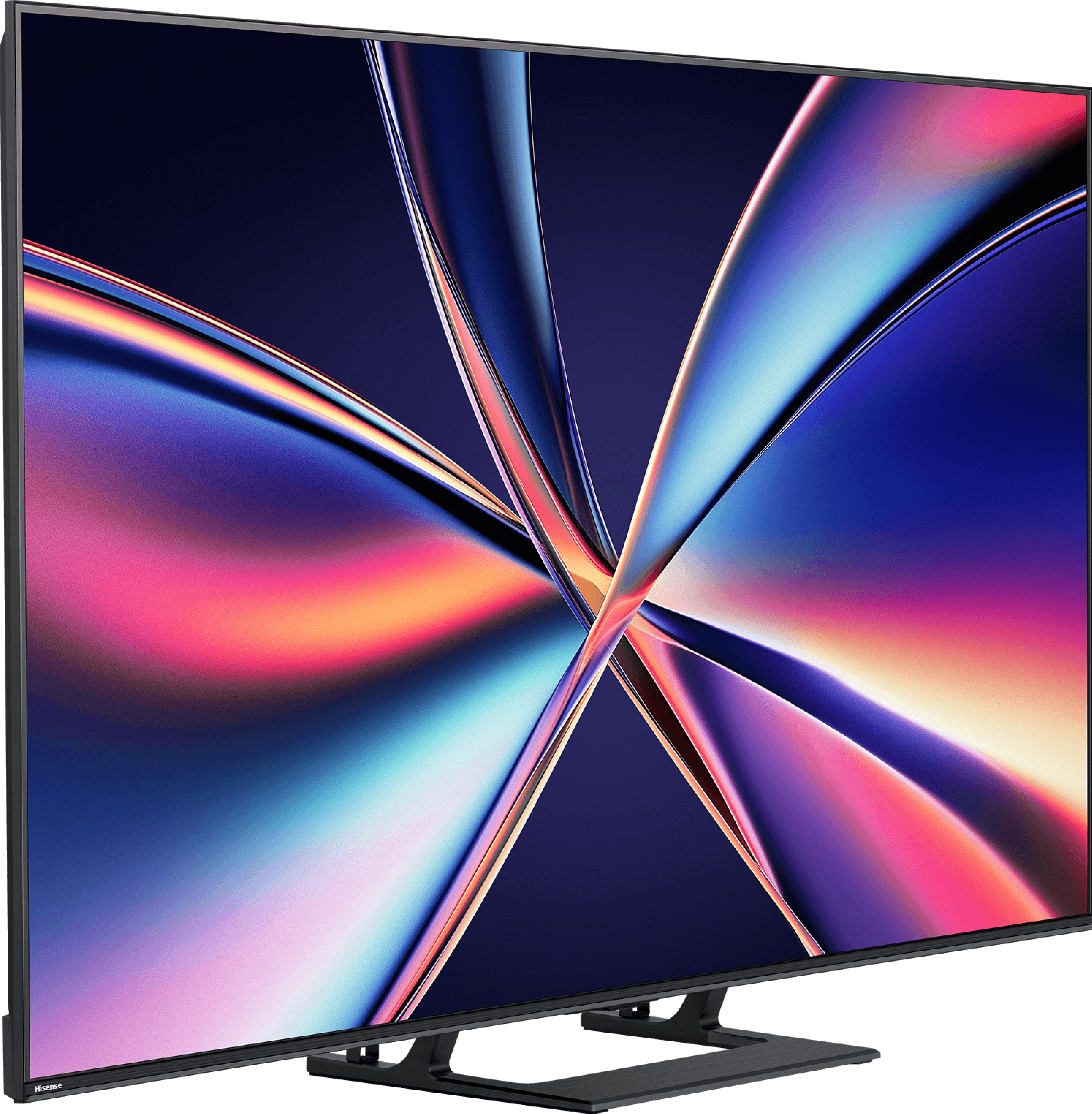
Panel type: LCD VA (wide viewing angle)
Resolution: 3840x2160
System: Tizen
Model year: 2024
Complete the survey to find out the result

Panel type: LCD VA
Resolution: 3840x2160
System: VIDAA
Model year: 2025
Complete the survey to find out the result

Overall rating
7.8
7.2
Movies and series in UHD quality
7.9
6.7
Classic TV, YouTube
7.9
6.8
Sports broadcasts (TV and apps)
7.7
6.5
Gaming on console
9.1
8.0
TV as a computer monitor
8.6
8.6
Watching in bright light
6.4
6.2
Utility functions
7.7
8.9
Apps
8.7
7.7
Sound quality
6.9
7.2
Complete the survey to find out what fits your preferences
Advantages
High brightness
Good contrast
Intuitive Tizen operating system
Great for gamers and sports fans (HDMI 2.1, 144Hz, low input lag)
Wide viewing angles - unusual for VA panels
Great contrast and deep blacks
Very good smoothness of tonal transitions (close to reference level)
High brightness
Supports 4K 144 Hz and even 240 Hz in Full HD
VRR, ALLM, G-SYNC – a full package for gamers
Low input lag
Many classic TV features built into the VIDAA system
Disadvantages
No recording function
No support for DTS format - may be problematic for those using Blu-ray
No support for HGiG (makes setting HDR on consoles difficult)
Poor viewing angles – typical for VA panels
Closed VIDAA system – lack of some applications
Inferior sound quality compared to the twin model U7Q
Our verdict
Hisense E8Q is a television that clearly draws heavily from the U7Q model – and that’s a great thing. After all, this is its European version, not another “slimmed down” mutation. After just a few moments with this screen, it’s clear that the E8Q is putting up a fight. And in many areas, it really succeeds. To start with – what impresses is that the blacks are deep, the contrast is high, and the brightness exceeds the threshold that we can simply call satisfactory. Add to that nearly perfect fluidity of tonal transitions, and we have an image that looks very mature, especially for this price segment. In gaming? Just as good. VRR, ALLM support, 144 Hz in 4K, and even 240 Hz in Full HD – it’s hard to find fault here. Well… almost. Because the E8Q has one additional flaw compared to the U7Q – the sound. In our unit, at moderate volume levels, the back of the cabinet began to resonate, producing rather unpleasant crackling noises. This might be a flaw of the test unit, but since the U7Q simply performed better – it’s worth noting. Especially if you find both models at a similar price. We can confidently state that the E8Q is a television that can confidently fight for the attention of those looking for a quality Mini-LED at reasonable prices. If a good price opportunity arises, it’s definitely worth it – because we receive almost the same as in the U7Q. And that means a really solid picture, excellent gaming features, and overall very good equipment that you can stick with for a while.
TV appearance





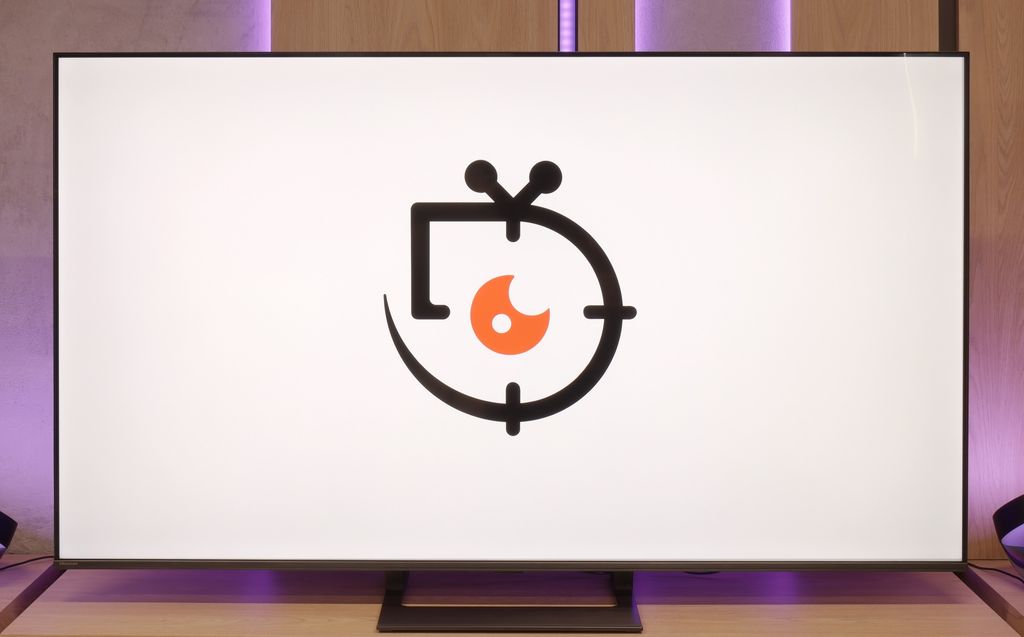
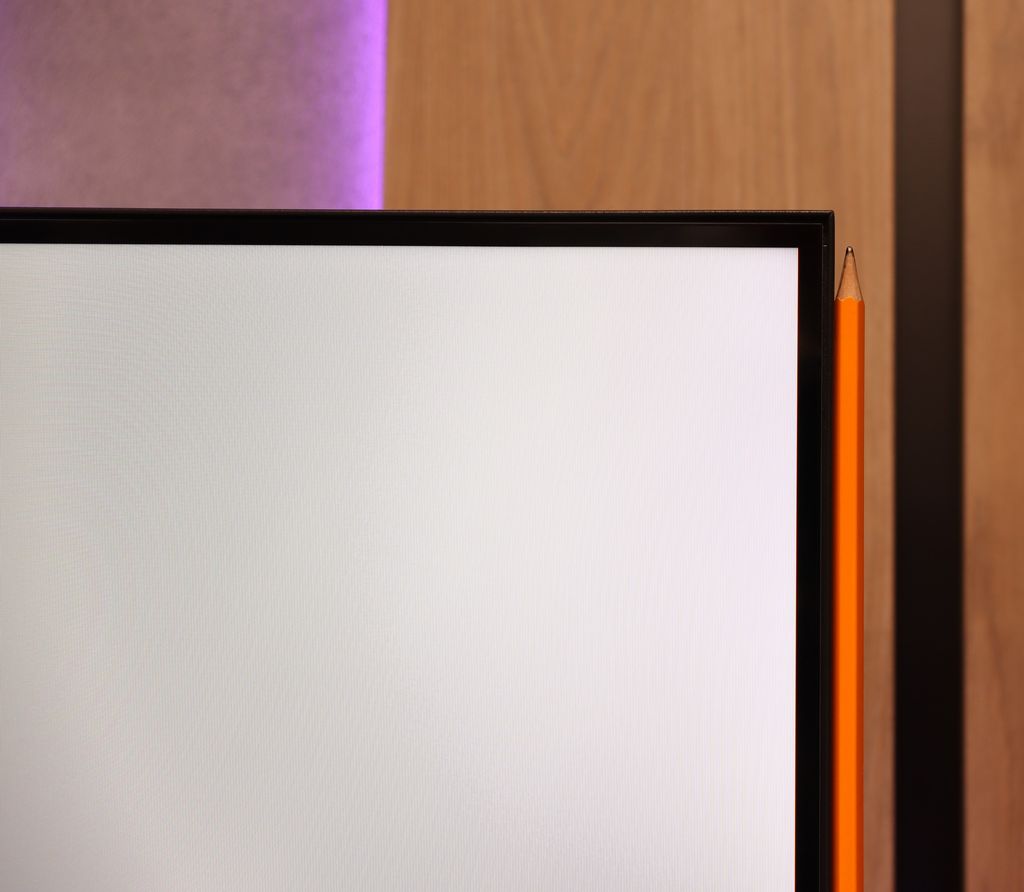
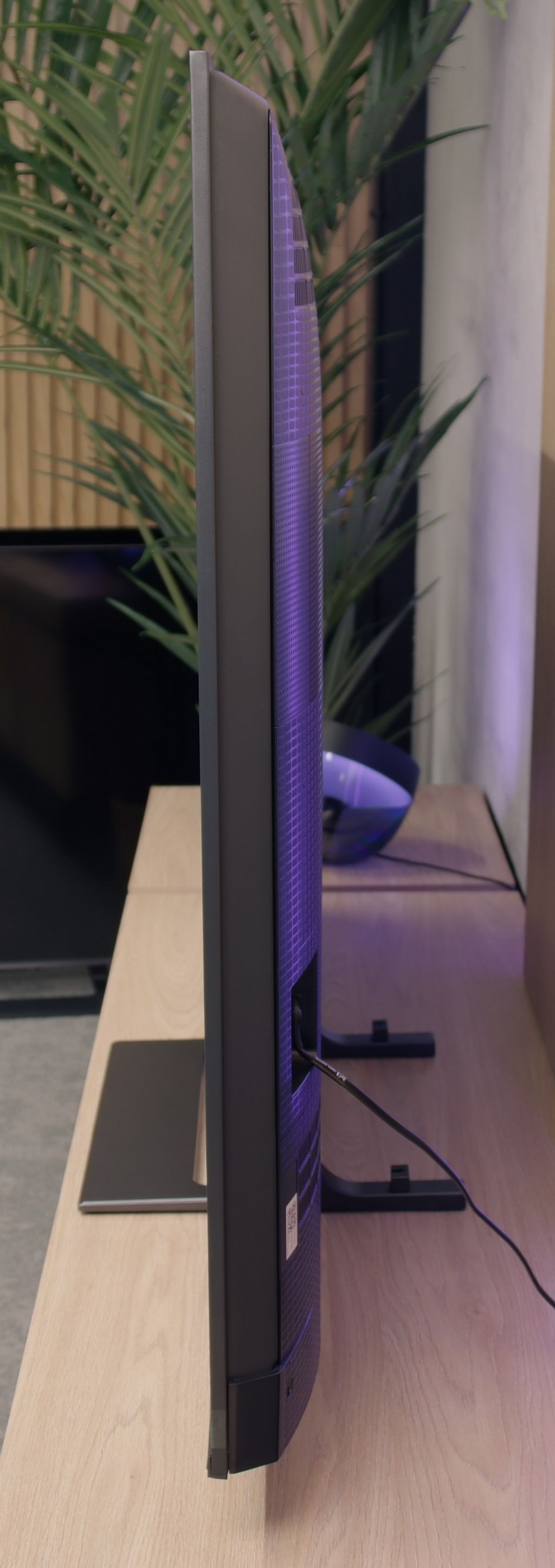
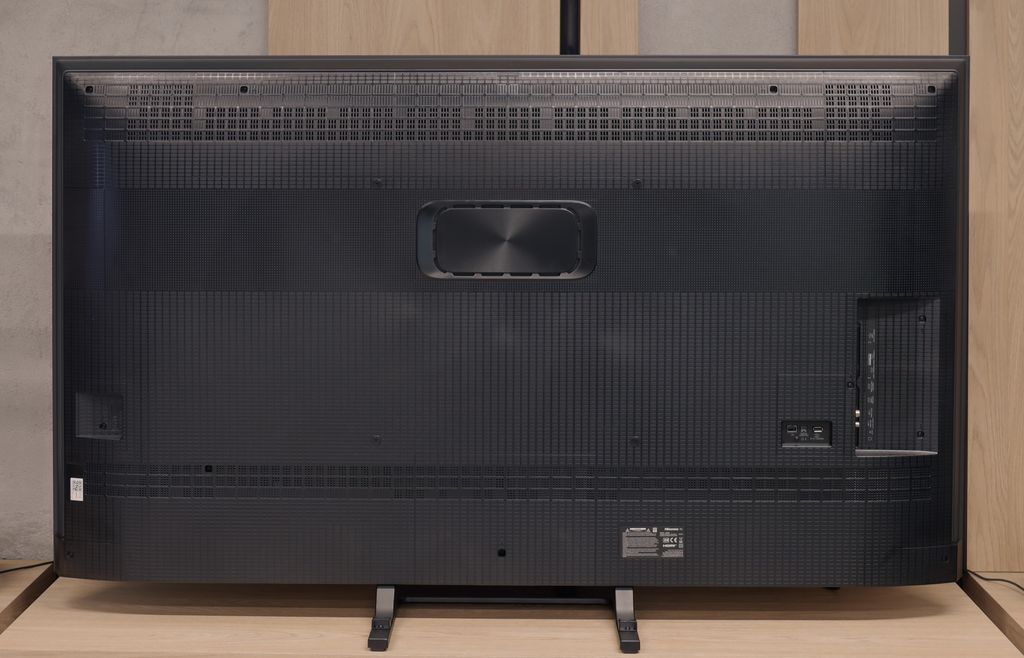
Contrast and black detail
7.9/10
7.6/10
Local dimming function: Yes, number of zones: 504 (36 x 14)
Local dimming function: Yes, number of zones: 220 (10 x 22)
Contrast:

Result
∞:1

Result
69,000:1

Result
∞:1

Result
5,500:1

Result
2,700:1

Result
277,000:1

Result
43,700:1

Result
15,750:1

Result
8,850:1

Result
6,350:1
Halo effect and black detail visibility:

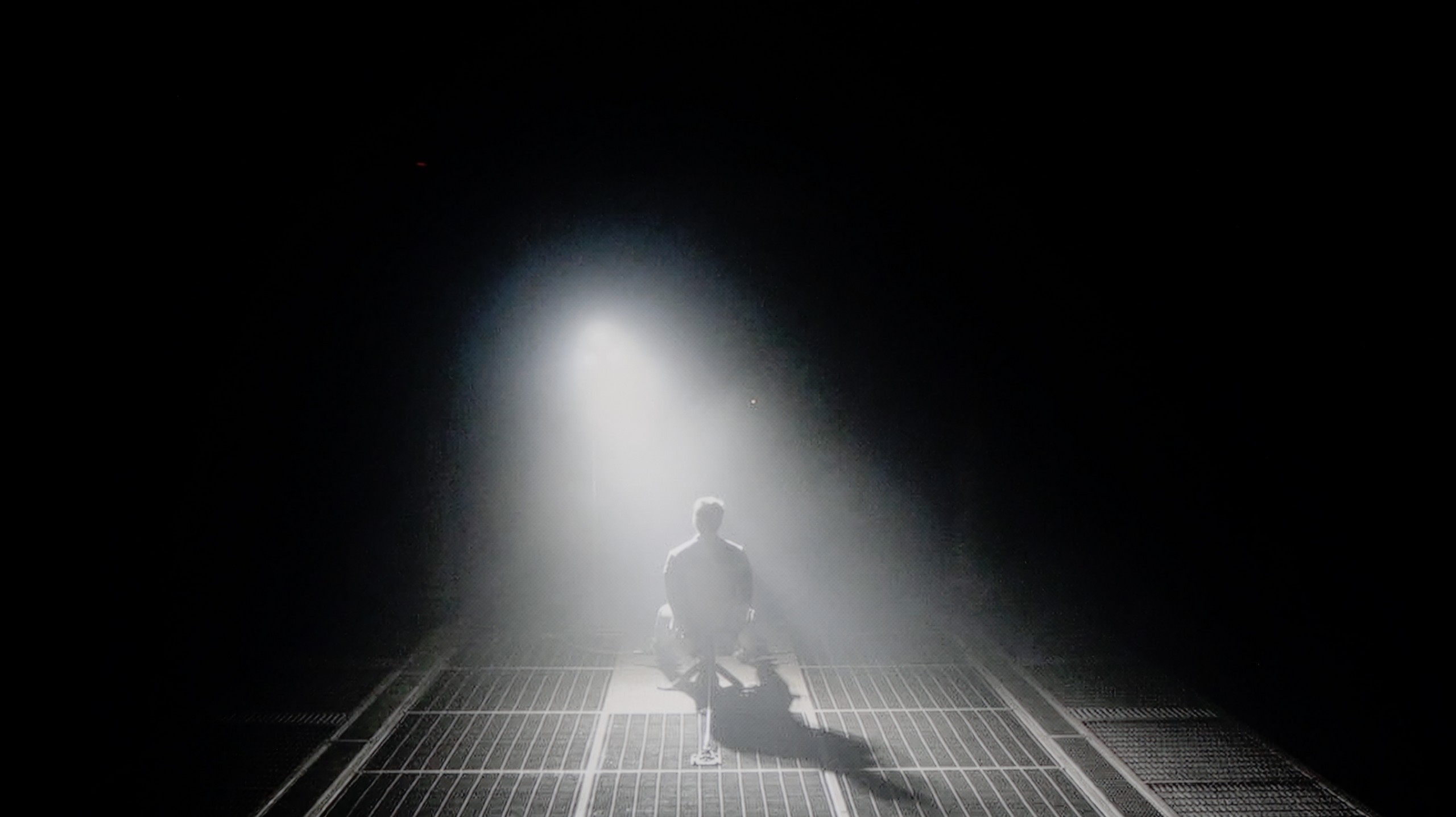
Samsung QN92D is one of the top models of NeoQLED 4K (mini LED) from the Korean manufacturer for 2024. Although it does not offer as many dimming zones as its more refined sibling Samsung QN92D, the number of 504 dimming zones in the 55-inch version is still impressive. The VA panel works well with this solution, providing excellent results in terms of contrast. The contrast in Samsung QN92D is outstanding for a non-OLED television. Even in difficult scenes, like those from the movies "Oblivion" or "Arrival," the contrast is nearly infinite and can compete with the best televisions in the OLED segment, which is quite unusual among LED-lit televisions. However, mini LED diodes have their limitations compared to organic panels, which can lead to some issues. For example, on the last test screen from Pioneer, the television has significant difficulties. This may be due to a very aggressive dimming algorithm, which sometimes causes the mini LED diodes to struggle with what to do – whether to illuminate certain elements or maintain the blacks. Despite these drawbacks, Samsung QN92D is one of the best LCD televisions in terms of contrast and blacks.
Similar to the U7Q, the E8Q model uses a VA panel and Mini-LED backlighting. The number of dimming zones also remains at a very similar level – in the 65-inch variant we tested, we counted 220 zones, which is exactly the same as in the U7Q. On paper, it looks really good for this price segment, and even better – in practice. The contrast is high, and the black can be really deep. In many scenes, the lights are clearly separated, and the image gains a sense of space. This is one of those cases where Mini-LED shows it can come close to OLED quality – of course, assuming we understand the limitations we have to consider. In very challenging scenes, there may be slight brightening or a minor halo effect around bright objects, but these are phenomena typical of this technology and are not very noticeable. Ultimately – the contrast and blacks in the E8Q are really solid, nearly identical to the U7Q model. It's hard to nitpick, especially when we look at the price of the television.
HDR effect quality
6.7/10
4.5/10
Luminance measurements in HDR:

Result
1947 nit

Result
617 nit

Result
738 nit

Result
271 nit

Result
1479 nit

Result
531 nit

Result
148 nit

Result
320 nit

Result
100 nit

Result
625 nit
Scene from the movie “Pan” (about 2800 nits)


Scene from the movie “Billy Lynn” (about 1100 nits)


Static HDR10


Dynamic: HDR10+
Dynamic: Dolby Vision


HDR luminance chart:
Hisense E8Q
Luminancja HDR
Luminance of RGB colors
Samsung Neo QLED QN90D / QN92D
Luminancja HDR
Luminance of RGB colors
During synthetic tests, Samsung QN92D showed its incredible capabilities in terms of brightness. The charts clearly indicate that the television can achieve an impressive 2000 nits, giving it a solid power base to compete with the best models on the market. Such a result places it at the forefront, especially in the context of displaying HDR content, where brightness plays a key role. However, what happens when we move the tests to real film scenes? In favourable conditions, such as the first scene from the movie Life of Pi or the last scene, where the image is completely flooded with light, Samsung QN92D can achieve almost laboratory results, impressing with its brightness. The situation looks different when small, bright objects appear on a dark background, as in the fourth scene from the movie Sicario. In such cases, the television doesn't perform as well – brightness drops several times, and maximum values in the best conditions are around 600 NITS. Similar to contrast, these limitations arise from the use of an aggressive local dimming algorithm. This algorithm aims to reduce the 'halo' effect around bright objects on a dark background, but often at the expense of overall brightness. As a result, while the television performs well in bright scenes, its ability to display full brightness is limited when it comes to small, vivid elements.
Since the E8Q is a twin of the U7Q, it’s no surprise that the HDR effect quality is almost identical. On paper, it looks promising – a peak brightness of 800 nits can impress in many scenes. Moments like light flashes in “The Meg” or shots of the sun in “Life of Pi” can indeed create a “wow” effect. But the longer we watch, the more we notice the limitations. The problem arises when small, bright details need to be shown against a dark background. In such situations, the dimming algorithms try to protect the contrast, but in the process, they also dim what should shine the brightest. Instead of dazzling details, we get almost invisible points of light. This is typical for Mini-LED in this price segment and is not surprising – but it’s worth knowing that the HDR effect will not always be fully preserved. Fortunately, the colour reproduction provides reasons to be pleased. A coverage of the DCI-P3 palette of about 94% is a very good result, and the quantum dot layer used (more precisely, PFS) does its job – colours are saturated and vibrant, especially with 4K content.
Factory color reproduction
6.1/10
6.5/10


Factory Mode
After calibration
The best mode that reproduces colours best on the Samsung QN92D has consistently been the Filmmaker mode for years. While it generally offers decent colour quality, it is not free from significant issues. Let's start with the analysis of HD/SDR image quality. The biggest challenge here is the white balance – the graphs show considerable instability, with a clear dominance of red making the image too warm. This distortion causes hues to be unnaturally shifted towards warmer tones, which can negatively affect the perception of materials with natural colours. Contrast, based on the gamma chart, although not the worst, remains far from ideal, impacting the overall image quality, especially in darker scenes.
This issue also persists with 4K materials, such as series or films of higher quality. In this case, the white balance also turns out to be faulty, with noticeable deficiencies in blue and red colour, leading to tonal shifts. Tests using the Colour Checker tool confirm these problems – all colours tend to skew towards yellow shades, further distorting the natural appearance of the image. Although the Filmmaker mode is one of the best available modes for watching cinematic content, it still requires improvements, especially in terms of colour accuracy and white balance.
Testing the Hisense E8Q in Filmmaker mode, we were hoping for a potentially neutral picture resembling the director's vision. Unfortunately – although it doesn't look too bad on paper (the colour reproduction errors aren't significant), in practice the image feels somewhat unnatural. The reason? The blue colour is boosted too strongly and there is a deficiency of red in the white balance. The effect? Scenes appear cool, and the white seems slightly bluish. Alongside the U7Q model, we also noticed a specific approach to brightness management here. The brightness reproduction curve for HDR content (EOTF) shows that the TV can significantly dim small, bright elements on the screen to maintain contrast – but sometimes it goes too far. On the other hand, it can excessively brighten larger, very bright areas, which disrupts tonal balance. It's a compromise that may not suit everyone – especially if you want a potentially faithful picture straight out of the box.
Color reproduction after calibration
8.7/10
7.4/10



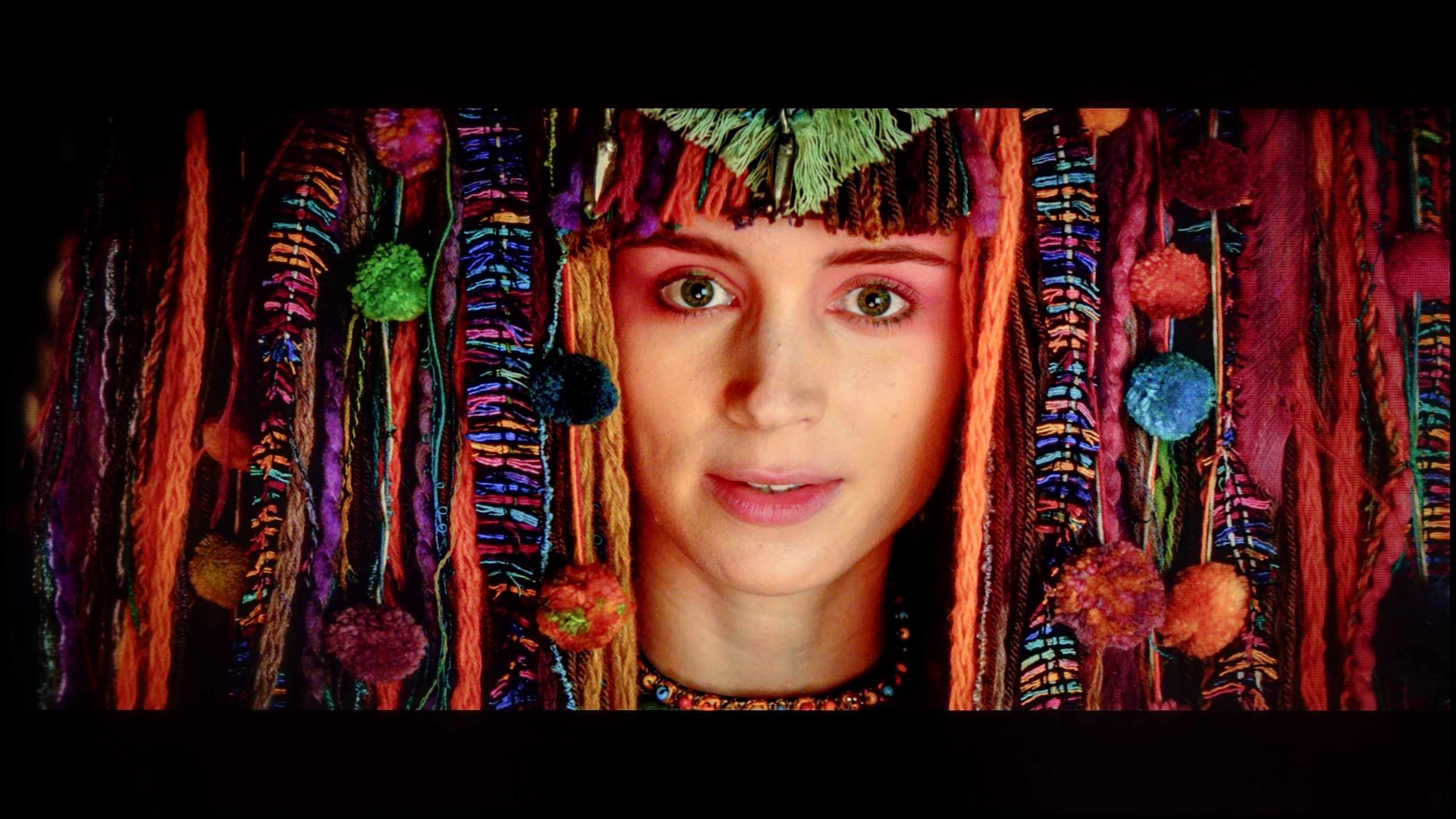
After calibration, the Filmmaker mode on the Samsung QN92D television shows significant improvement, particularly in the SDR content range. The white balance has been greatly enhanced – the previous colour misalignment and dominance of red have been eliminated, resulting in a more natural colour reproduction. In terms of brightness, although the gamma chart did not require significant adjustments, it has been stabilised, which affects the overall picture quality.
Regarding high-quality materials, the white balance has also improved in this case. However, it is worth noting the contrast. The EOTF curve, which illustrates the values in this area, appears correct at first glance. However, upon closer inspection, the television struggles to maintain appropriate contrast in film materials. The EOTF curve reveals some discrepancies, suggesting that despite the progress, there are still areas that require improvement in this aspect. The television continues to strive for excellence in contrast reproduction. A strength of this television is the saturation of colours. Skin tones are rendered very well, and although some colours may be slightly oversaturated, the overall effect looks really attractive – the colours appear rich and vibrant.
Despite some shortcomings in contrast, after calibration, the Filmmaker mode on the Samsung QN92D offers excellent image quality, with natural colour reproduction, making it a great choice for watching movies.
Calibration of the Movie mode yielded really good results, especially regarding SDR content. The white balance was successfully adjusted, giving the image a natural look – it appeared almost reference-level. The colours were well-saturated, and the overall experience of the content improved significantly. Unfortunately, when we switched to HDR materials, the familiar issues from the U7Q model returned. The TV still likes to "do its own thing," as seen from the analysis of the EOTF brightness characteristics – despite calibration, the E8Q still darkened small details in the shadows, while brighter parts of the screen were sometimes excessively boosted. In practice, this means that in darker scenes, some of the smallest details could simply disappear. Although it's worth noting that the entire calibration process brought a lot of good, not everything can be bypassed – even with the use of professional tools. The E8Q can impress with its picture, but in HDR content, its construction limitations become apparent, and it's worth keeping this in mind.
Smoothness of tonal transitions
9/10
9.9/10












The fluidity of tonal transitions on the Samsung QN92D TV is excellent, making the image look exceptionally natural, without visible disturbances. In scenes with complex colour gradations, the TV performs brilliantly, providing smooth and uniform transitions. Competing OLED TVs in a similar price range could successfully take a cue from this, as the Samsung QN92D offers quality that places it on par with models equipped with QD-OLED panels.
In this category, the Hisense E8Q really demonstrates its quality. The transitions between colours are very smooth, without any "steppings" or clear boundaries between tones. The image looks natural, and the colour gradation performs exceptionally well – even in more challenging scenes. If there are any minor imperfections, they are subtle enough not to be noticeable. It's hard to find fault here – it looks almost perfect.
Image scaling and smoothness of tonal transitions
7.2/10
6/10
Smooth transition function


Image without overscan on the SD signal


Let's check how the Samsung QN92D TV performs with tonal transitions in very poor quality materials. The noise reduction feature shows good effectiveness, improving the fluidity of tonal transitions even in difficult conditions. However, it should be noted that, similar to other Samsung TVs, the effectiveness of this feature can lead to the removal of desirable elements, such as film grain, which can sometimes affect the authenticity of the image.
When it comes to digital processing, the Samsung QN92D TV also performs excellently. During tests, the image looked very good, with the model presented in a natural and correct way. Details, such as branches in the background, were reproduced with great precision, highlighting the TV's ability to enhance the quality of low-resolution materials.
In the case of older materials of lower quality, gentle smoothing of tonal transitions often comes in handy. The Hisense E8Q, like the U7Q, has a "Smooth and Gradient Picture" feature, but unfortunately, its effectiveness leaves much to be desired. The "Low" setting is nearly invisible in operation, while higher settings blur details instead of improving transitions. The good news is that the feature does not compromise film grain, which means it does not degrade the structure of the image. On the positive side, scaling is commendable. The TV can reasonably convert older content to a higher resolution – without artificially accentuating contours or excessive sharpening. Although it doesn't match the best models in this category, it performs quite well for its class.
Blur and motion smoothness
7.5/10
7.5/10


Blur (native resolution, maximum refresh rate):



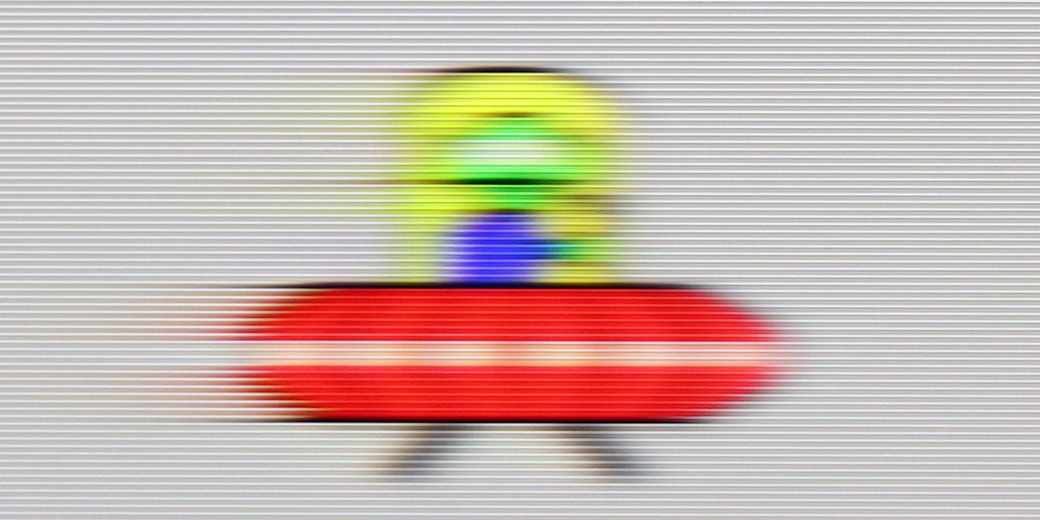
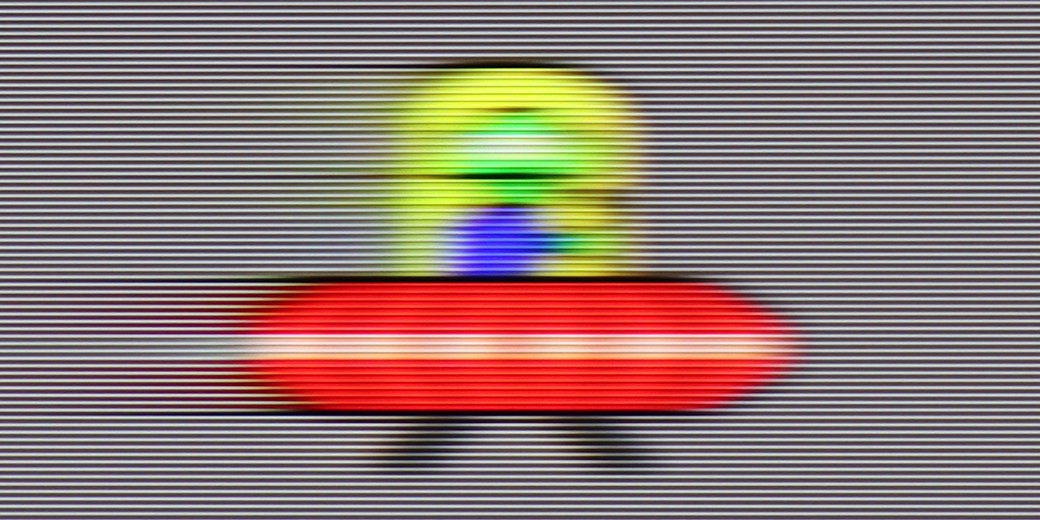
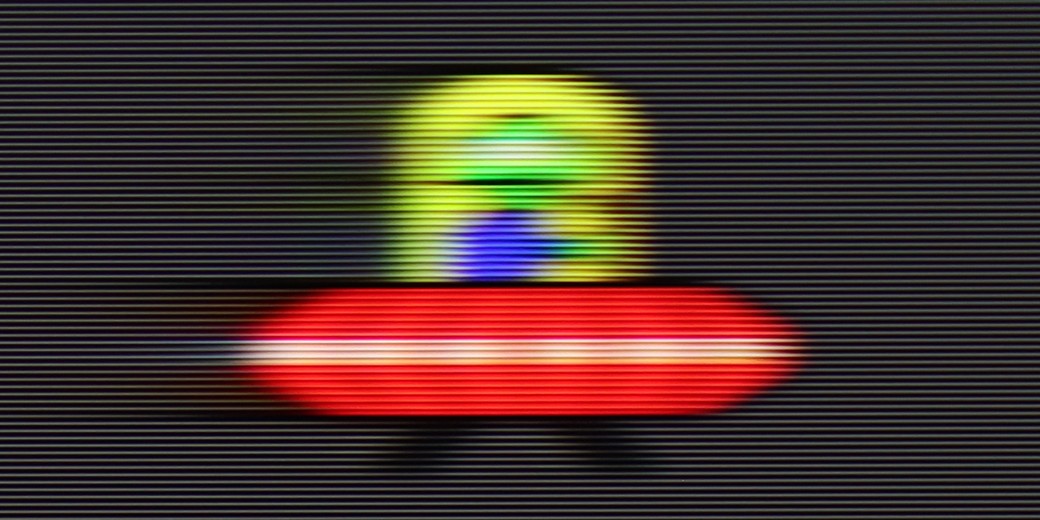
Blur (BFI function enabled):
Image flickers in this mode






Smużenie ():
Smużenie (4K 120Hz):
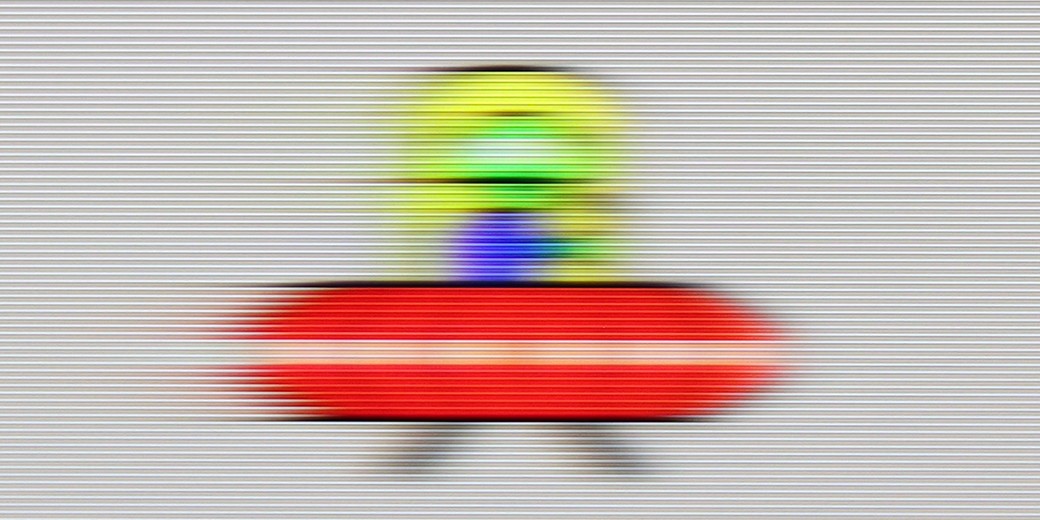
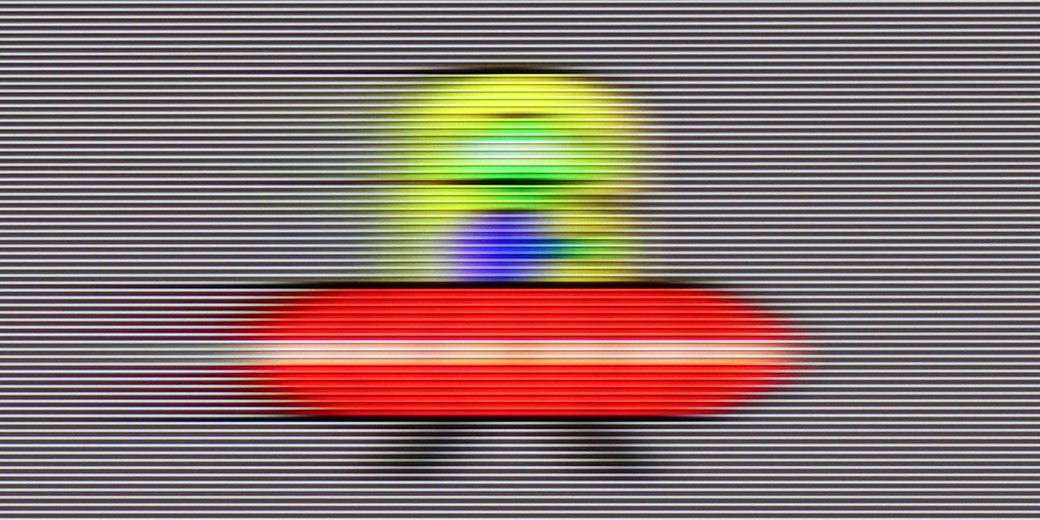
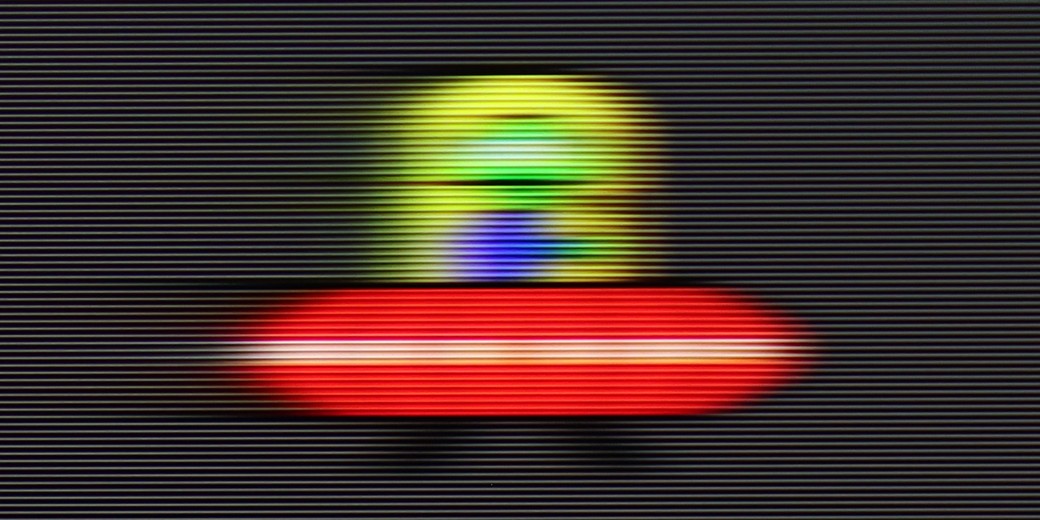
The Samsung QN92D television is equipped with a 144 Hz panel; however, when watching content using the smoothness feature, the maximum refresh rate is 120 Hz. As a result, both gamers and sports enthusiasts will be satisfied with the picture quality. It’s also worth mentioning the available options for image enhancement, such as the "motion blur and judder reduction" feature, which allows users to adjust smoothness to their individual preferences on a 10-point scale. Motion blur reduction increases the sharpness of fast-moving objects, while judder reduction smooths out motion, eliminating the "stutter" effect. With these advanced settings, one can achieve optimal visual experiences, making the Samsung QN92D perfect for both dynamic scenes and intense gaming.
In terms of motion blur, the television performs really well, and it’s hard to pick faults. The only note we might have is a slight overshoot effect noticeable on dark backgrounds during our test with "Ufoludkiem." Nevertheless, thanks to the advanced smoothness settings, the Samsung QN92D excels in both dynamic scenes and intense gaming.
Similar to the U7Q, the E8Q model is a fast television designed with dynamic content in mind. It supports a 144 Hz refresh rate at 4K resolution, and if for some reason someone is still gaming in Full HD – it can even reach 240 Hz. This is a significant advantage, especially for PC users looking for maximum smoothness. In everyday use, the television performs very well. The “Ultra Motion Smoothness” mode gives us two sliders, allowing you to set the picture to your preference – whether it's more cinematic with the film frame preserved or highly smoothed, almost “TV show-like.” It's good that the manufacturer provides a choice here, instead of imposing one style. On sports material, live broadcasts, or in games – motion looks clean and stable. Sure, it’s not at the OLED level, but for this price range, the E8Q does a really good job.
Console compatibility and gaming features
9.5/10
8.5/10
- ALLM
- VRR
- VRR range48 - 144Hz48 - 240Hz
- Dolby Vision Game Mode
- Correct implementation of HGIG
- 1080p@120Hz
- 1440p@120Hz
- 4K@120Hz
- Game bar



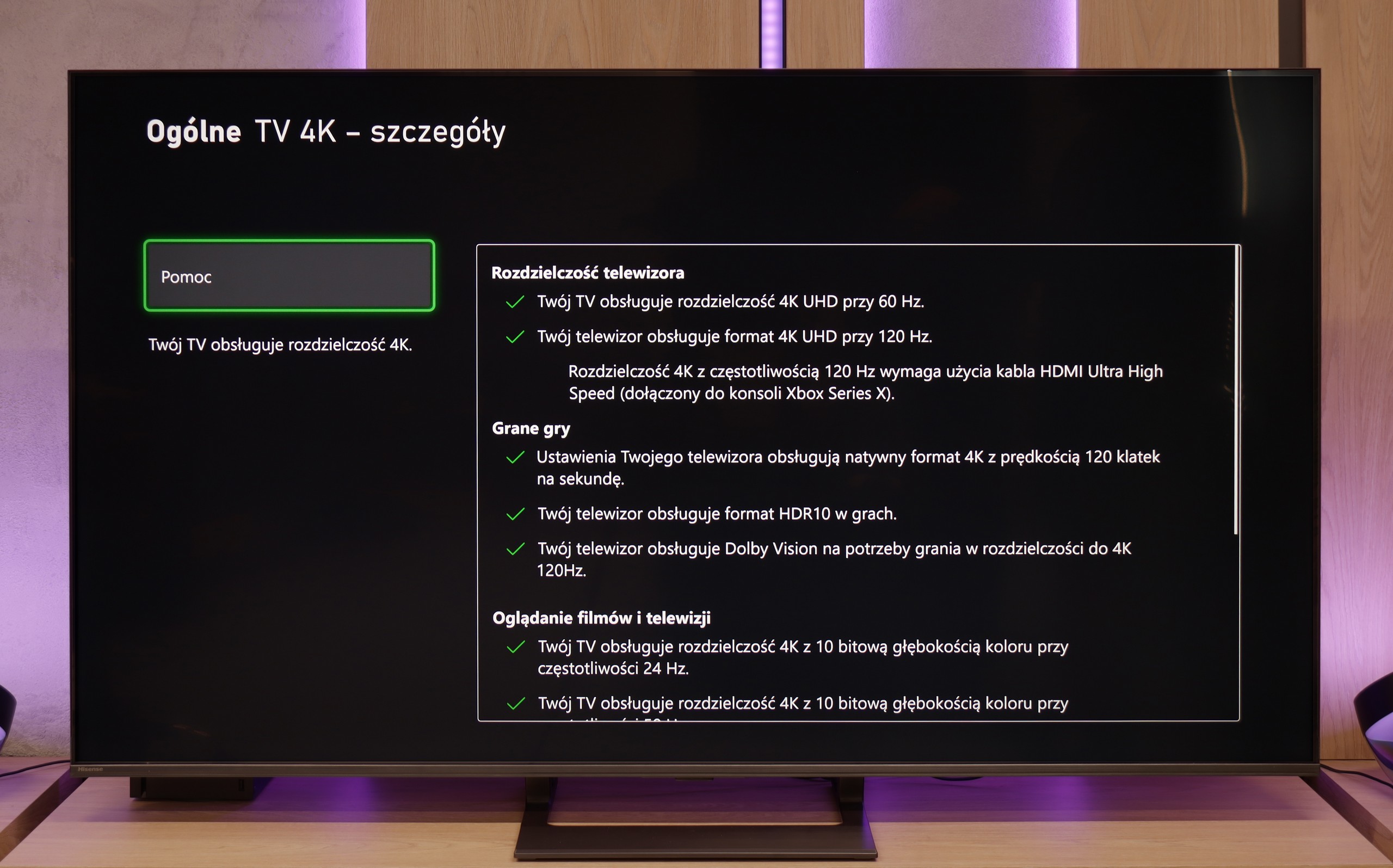

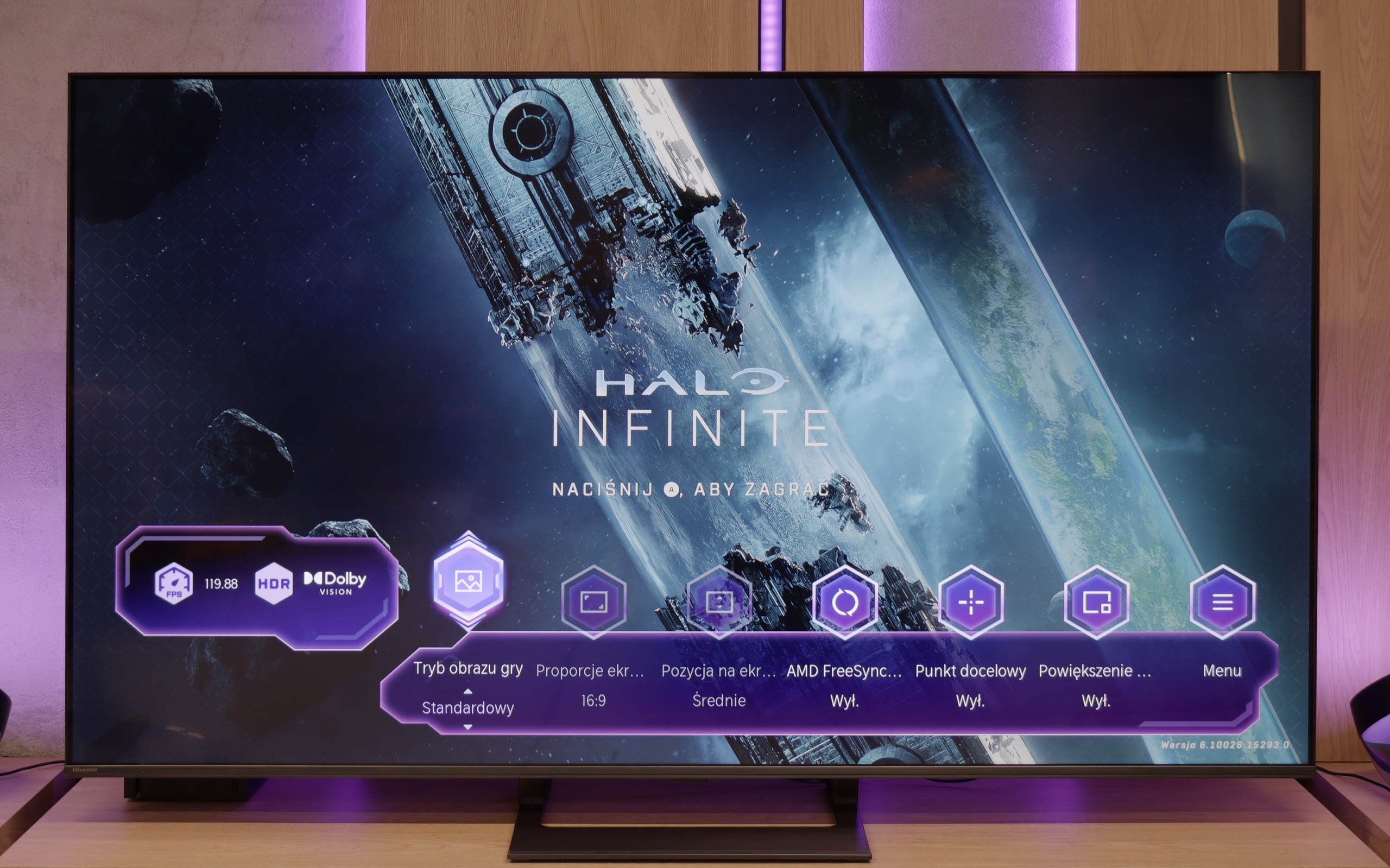


The television Samsung QN92/QN90 is an excellent choice for avid gamers, deserving of the highest recommendations. This model offers practically all the features available on the market in terms of gaming, making gameplay even more exciting. One of the key differentiators is the 120 Hz panel, which ensures exceptional motion smoothness, crucial during dynamic action games. The television also boasts low input lag, guaranteeing instant reactions to player commands. Additionally, technologies such as VRR (Variable Refresh Rate) and ALLM (Auto Low Latency Mode) adjust the refresh rate and automatically switch the television to game mode, translating to even better gaming experiences. Another advantage is the Xbox app, which allows gaming of favourite titles directly on the television, eliminating the need for a console. This is a typical feature of Samsung televisions, making them exceptional in the gaming world.
Auto Motion Plus Game is a feature that really deserves praise for Samsung. It is a motion smoother that works wonderfully in games, creating the impression of a higher frame rate – a 30 frames per second image looks like 45, and 60 Hz becomes close to 90 Hz. Importantly, this feature does not introduce significant lag (input lag does not exceed 25 ms), so it does not negatively affect gameplay comfort, unlike many other smoothers available on the market. This allows gamers to enjoy a much smoother image without compromising responsiveness.
Hisense E8Q does not hide its gaming pedigree. Just the specifications reveal that we are dealing with a television that will perform excellently as a gaming screen. Variable Refresh Rate (VRR)? It's there. Automatic Game Mode switching (ALLM)? That's there too. Additionally, there's impressive refreshment – 120 Hz in 4K or even 240 Hz in Full HD. Such a set is rare in this price segment. Everything runs smoothly and without major surprises. The only missing element – similar to the U7Q – remains support for HGiG. It's a shame because this feature facilitates adjusting the brightness curve to the capabilities of the specific television, enhancing visual fidelity with the intentions of HDR game developers. Without it, manual tweaking of the settings is necessary, which does not always yield a satisfying result.
Input lag
9.9/10
9.7/10
SDR
HDR
Dolby Vision
The input lag category is crucial for gamers, and the Samsung QN90D performs exceptionally well in this aspect. Input lag values below 13 ms are impressive, meaning that the delay between pressing a button on the controller and the reaction on the screen is minimal. Such a low value allows for smooth and responsive gaming experiences, which will certainly please both casual gamers and professionals for whom every millisecond of reaction time matters. This makes the Samsung QN92D an excellent choice for those who value precision and speed in gameplay.
The E8Q handles delays very well. For 120 Hz content, the input lag is super low – practically imperceptible even for more demanding players. At 60 Hz, the values are slightly higher, but still comfortably within the "placebo" range – there's nothing to complain about. The biggest increase in latency was noted in Dolby Vision Gaming mode. The TV needs more time to process the signal then, but even in this scenario, it doesn't exceed 30 ms. These may not be ideal values, but for most players – especially console gamers – it won't be a problem.
Compatibility with PC
8.6/10
8.6/10


The television stands out with its high performance, supporting chroma 4:4:4 and offering exceptionally low input lag. These features allow users to enjoy fluidity and responsiveness, making it an excellent choice for office work and everyday applications. However, one noticeable drawback is the poor visibility of horizontal lines on dark backgrounds. On the test screen, letters on the right side appear more like vertical lines, which can be frustrating for some users. Nonetheless, the television generally works well with a computer, providing comfort in carrying out daily tasks. It’s also worth mentioning in this paragraph the "Remote PC" feature; thanks to Microsoft’s collaboration with the Korean giant, we can seamlessly pair Windows PCs and use Office 360 apps.
In terms of collaboration with the computer, the E8Q performs really well. It supports chroma 4:4:4 at full 4K resolution and the highest refresh rates, so the readability of fonts – even the smallest ones – is at a very good level. There are slight blurriness issues with exceptionally thin fonts, but in everyday use, it's hard to consider this a serious problem. A nice addition for PC gamers is the ability to achieve up to 288 Hz at lower resolutions. The E8Q communicates effortlessly with powerful graphics cards, making it an interesting choice not only for movies or consoles but also for gaming on the computer.
Viewing angles
7.1/10
3/10
In the case of TVs with VA panels, you can usually expect limited viewing angles, however Samsung QN90D surprises in this category. Thanks to the applied coating that widens the viewing angles, the TV offers really good performance, which is rarely seen in devices with this type of panels. Although VA panels are typically not the best in this regard, in this model the image remains clear and saturated even when viewed from the side, making it a great choice for larger rooms and group viewing.
E8Q, like most TVs with a VA panel, looks best when we're sitting directly in front of the screen. In this position, you can expect deep blacks, good colour saturation, and high contrast. Unfortunately, just shifting a little to the side causes the picture quality to drop – colours start to fade, and blacks become more grey than black. It's not surprising, but it's worth keeping in mind, especially if we plan to watch with a larger group from different spots in the lounge. On the bright side – in return, we get significantly better black levels than in IPS panels.
TV efficiency during daytime
6.4/10
6.2/10




Matrix brightness
Average luminance SDR
Hisense E8Q: 504 cd/m2
Samsung Neo QLED QN90D / QN92D: 629 cd/m2
The television performs well in bright rooms due to its high brightness, especially when watching standard television. A constant brightness level of 600 nits ensures excellent visibility even in intense daylight. Unfortunately, despite the use of a satin finish, handling reflections is average, which can affect viewing comfort. An additional downside is the matrix that improves viewing angles, which causes reflections of sunlight to spread vertically, potentially further reducing viewing comfort in a bright environment.
Hisense E8Q isn't afraid of bright interiors. Even when the sun is shining outside, the television can maintain good image readability. With a brightness level of around 500 nits, you can comfortably watch content during the day without feeling like everything is drowning in glare. The satin screen coating also helps to nicely minimise reflections – it doesn't completely eliminate them, but reduces them enough that they don't interfere with everyday viewing.
Details about the matrix
Subpixel Structure:

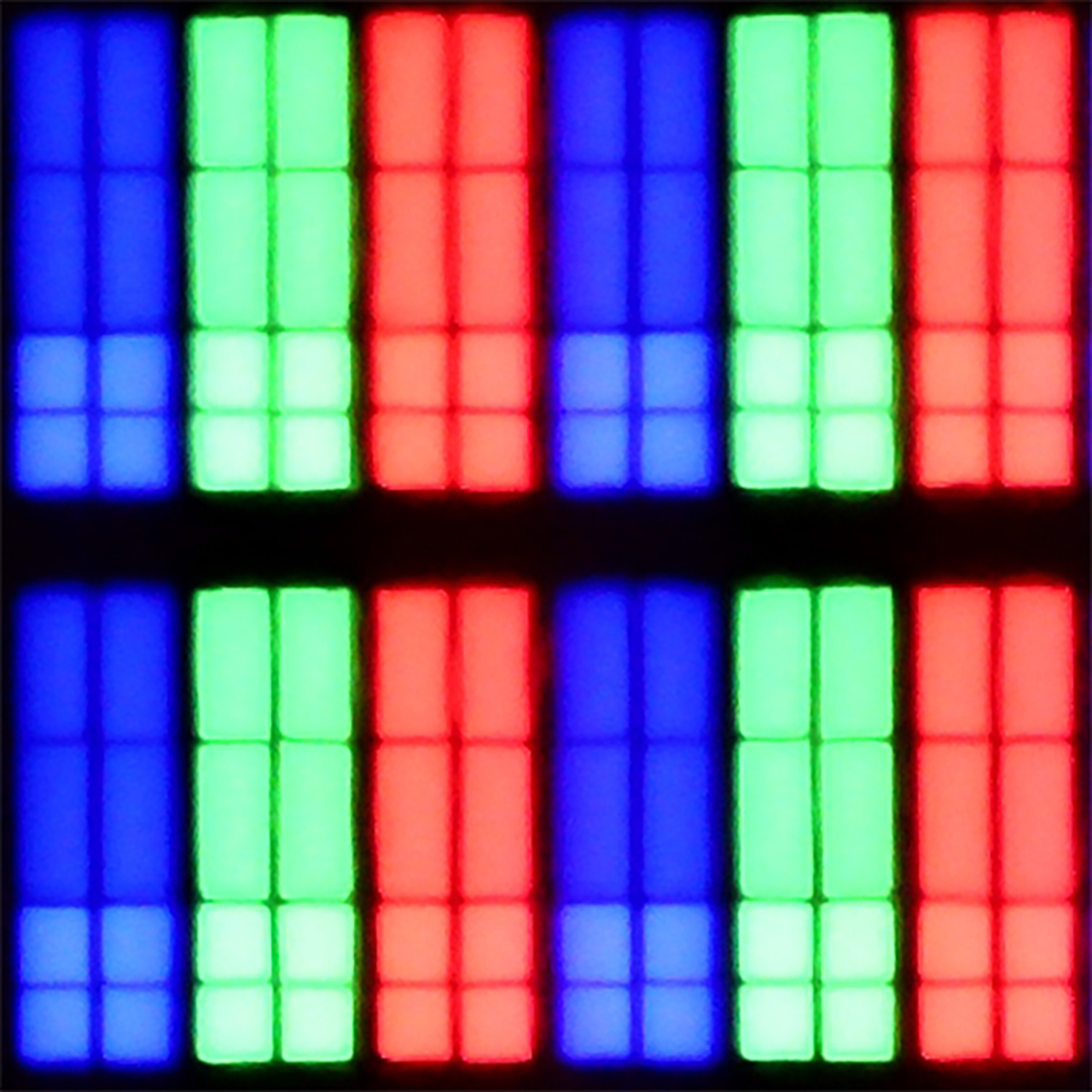
Panel uniformity:

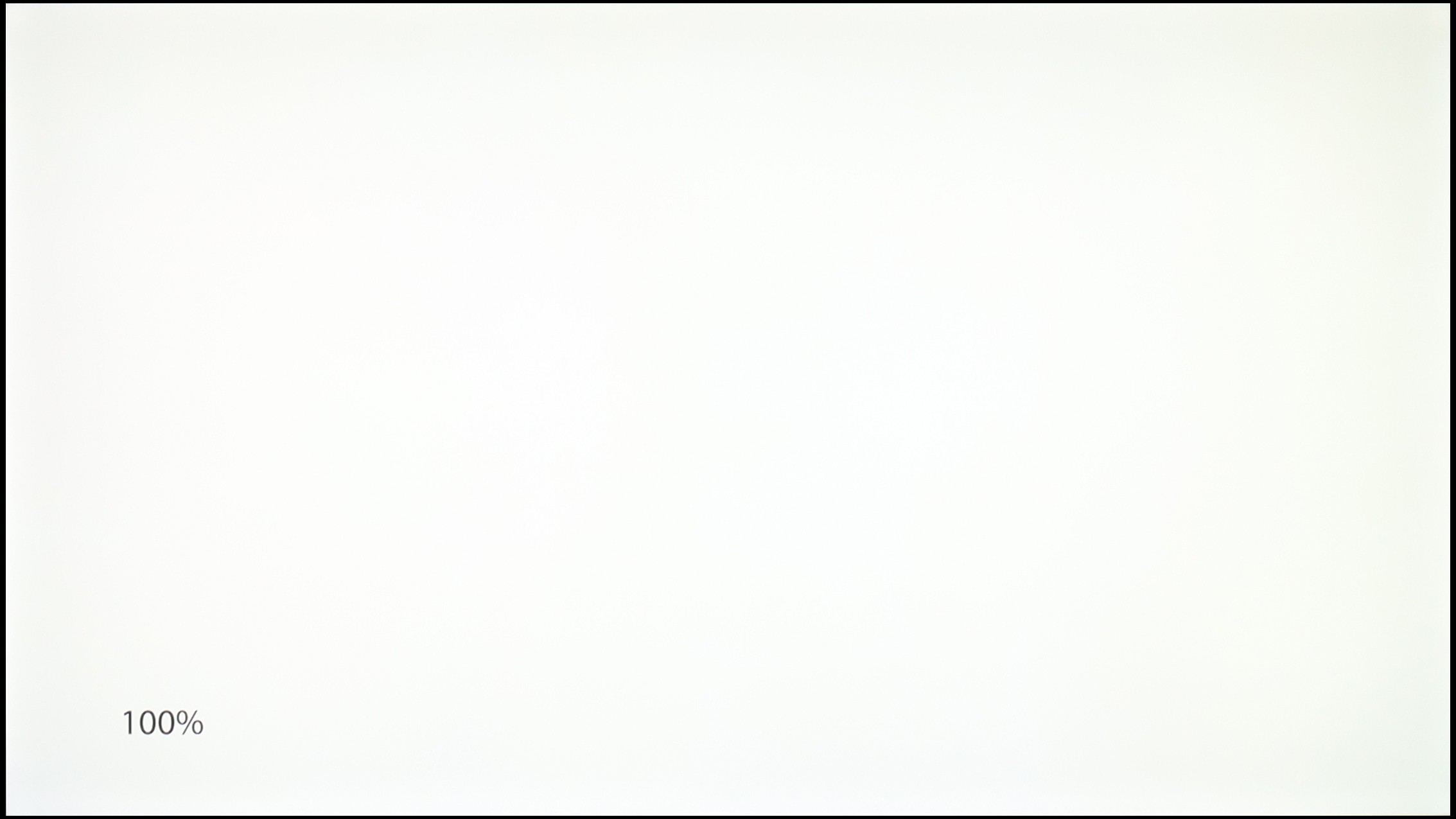
Samsung Neo QLED QN90D / QN92D
Hisense E8Q
TV features
7.7/10
8.9/10
- HDMI inputs0 x HDMI 2.0, 4 x HDMI 2.1 48Gbps2 x HDMI 2.0, 2 x HDMI 2.1 48Gbps
- Other inputsRCA (Chinch)
- OutputsToslink (Optical audio), eARC (HDMI), ARC (HDMI)Toslink (Optical audio), eARC (HDMI), ARC (HDMI), Mini-Jack (Headphones)
- Network InterfacesWi-Fi 2.4GHz, Wi-Fi 5GHz, Ethernet (LAN) 100MbpsWi-Fi 2.4GHz, Wi-Fi 5GHz, Ethernet (LAN) 100Mbps
- TV receptionDVB-T, DVB-T2, DVB-S, DVB-S2, DVB-CDVB-T, DVB-T2, DVB-S, DVB-S2, DVB-C
Classic features:
- Recording to USB (terrestrial TV)
- Recording programming
- Picture in Picture (PiP)
- RF remote control (no need to aim at the screen)
- Backlit remote control
- Teletext
- Audio only mode
- Possibility to connect Bluetooth headphones to the TV
- Possibility to simultaneously use Bluetooth headphones and the TV speaker
Smart features:
- AirPlay
- Screen mirroring (Windows Miracast)
- Wyszukiwanie głosowe
- Voice search in native language
- Ability to connect a keyboard and mouse


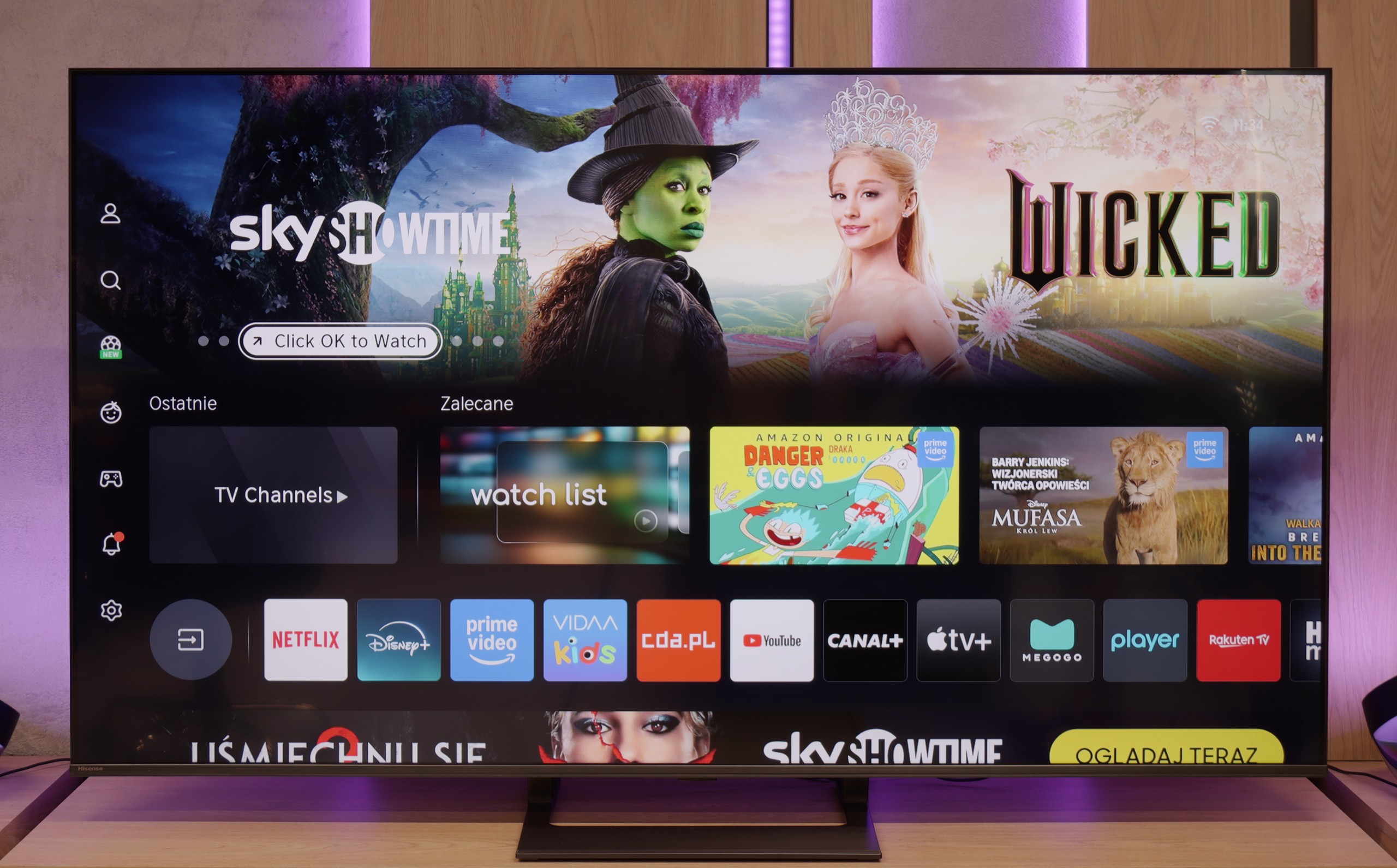
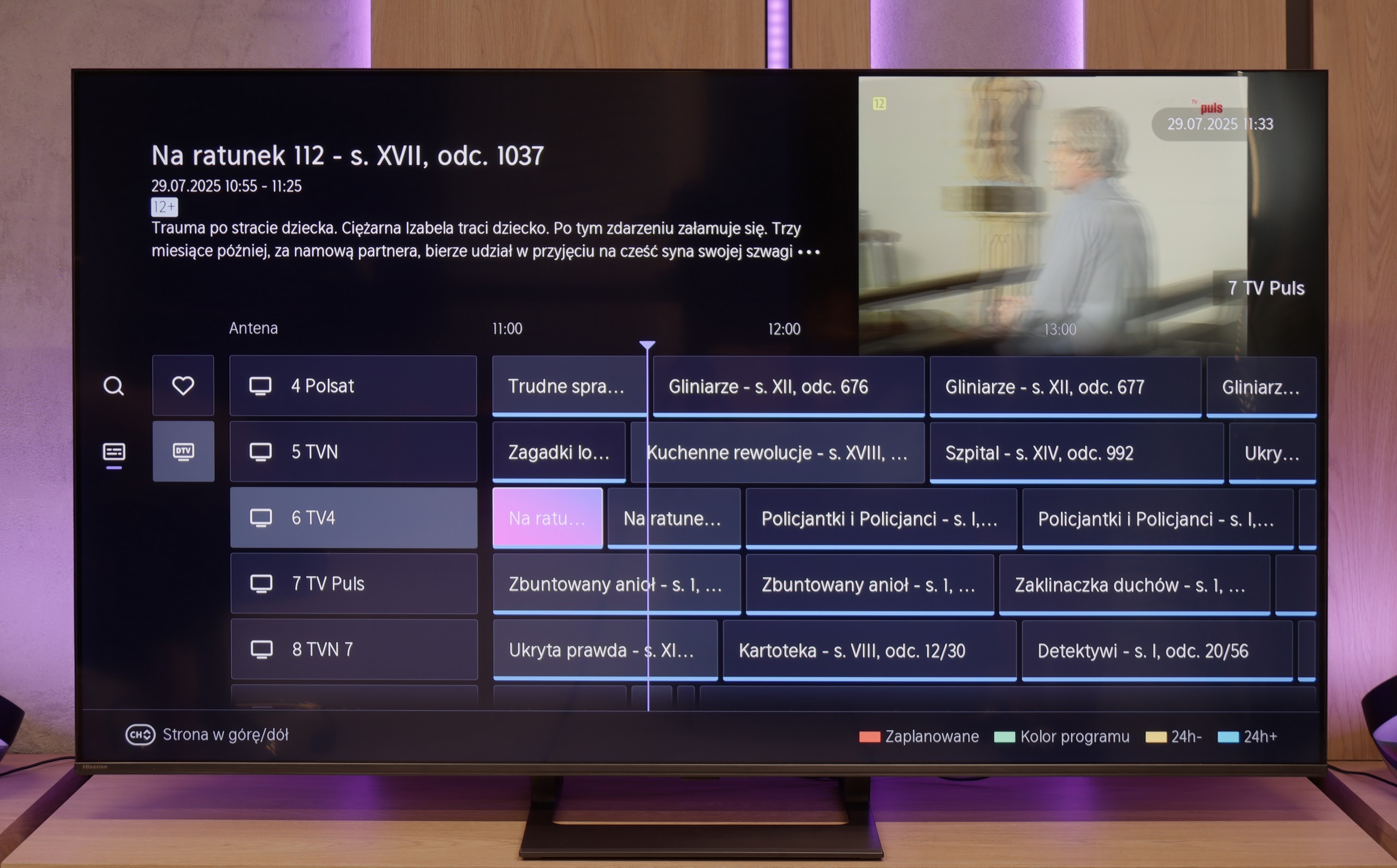


The Samsung QN92D television features a modern Tizen operating system, which offers users an intuitive and visually appealing environment. Tizen ensures smooth and fast navigation through applications, significantly enhancing the comfort of using the television. With an extensive ecosystem, users can easily connect the QN92D to other devices. The television supports many features that make everyday use easier, such as controlling set-top boxes with the remote, eliminating the need for multiple remotes. With AirPlay functionality, Apple device users can effortlessly stream multimedia from their iPhone. Additionally, there is a remote PC feature that allows users to access their computer on a large screen, as well as the Office 365 application, making the QN92D an ideal solution for both work and entertainment.
Furthermore, like many Samsung televisions, the QN92D offers Ambient Mode, which allows users to customise the appearance of the television to blend in with its surroundings. Users can display a variety of images or information, turning the television into an elegant part of the interior decor, even when not in use. Speaking of decor, it’s certainly worth mentioning the device's appearance. It is really very slim, around 2cm at its thickest point, which is impressive. The metal frame definitely gives the impression of a premium device, and the stand included in the box is sturdy.
However, for those using traditional television, the QN92D may prove to be a bit disappointing, as there is no television programme recording function available in the Polish market. Nevertheless, the television offers a Picture-in-Picture (PiP) feature that allows for simultaneous viewing of two programmes at the same time. The Samsung QN92D is a television with rich functionality that caters to both gaming enthusiasts and multimedia users, and it aesthetically fits into modern interiors.
Classic Features – E8Q
The Hisense E8Q is not just equipment for gamers or movie enthusiasts – it can also serve as an everyday TV for the whole family. We can record programs to USB, connect headphones or speakers via Bluetooth, and the entire interface – including the channel guide – is clear and easy to use. It only lacks a PiP function, but besides that, the set of classic features is really complete.
Smart TV – VIDAA System
The E8Q runs on the VIDAA system, which is becoming more refined every year. Voice search in Polish works flawlessly, and it's easy to stream content from a phone (AirPlay and screen mirroring). The system itself operates smoothly, without hiccups, although – as is often the case with closed platforms – there may be one or two less popular apps missing. It’s worth checking before purchase whether it has everything we use daily.
Playing files from USB
9.1/10
8.2/10
Supported photo formats:
Maximum photo resolution:

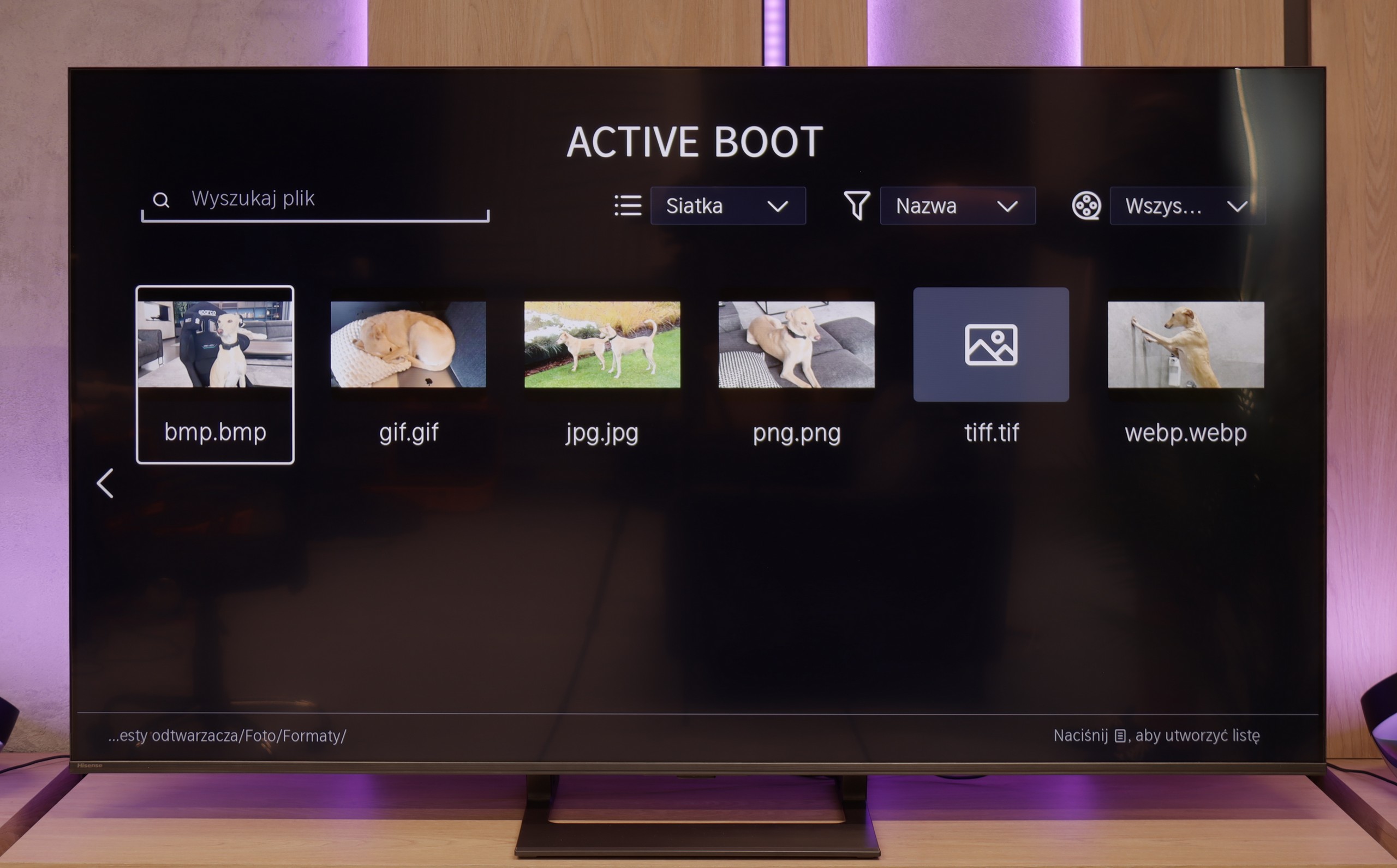
The built-in player in QN90D should satisfy a large portion of users. It will easily handle most popular video and audio formats. However, more demanding users may notice some shortcomings – it is not possible to play photos in HEIC format, which is popular on Apple devices, as well as several other, less common photo formats.
The built-in media player in the E8Q performs quite well. It supports most popular video and audio formats, and files from USB drives or external disks play without major issues. Polish characters? They're supported. Subtitles? They work. The only minor drawback is the occasional problem with displaying high-resolution images – especially those from cameras or smartphones. So if you're planning to show holiday photos on the big screen, it’s worth checking beforehand that they all load correctly from the memory of the disk or USB drive.
Apps
8.7/10
7.7/10














































Sound
6.9/10
7.2/10
- Subjective sound quality:6.9/107.2/10
- Dolby Digital Plus 7.1:
- Dolby True HD 7.1:
- Dolby Atmos in Dolby Digital Plus (JOC):
- Dolby Atmos in Dolby True HD:
- DTS:X in DTS-HD MA:
- DTS-HD Master Audio:
The television is equipped similarly to the QN95 with a speaker system featuring a 4.2.2 layout with a total power of 70W (the exception is the 50' variant with a 2.2 layout and the 43' with a 2.0 layout). Despite its very slim casing, the television sounds loud and clear, and the overall sound is well balanced. Points were deducted as per standard practice for every other Samsung model for the lack of support for the DTS format. It's also worth mentioning the proprietary Q-Symphony feature, which allows you to synchronise the sound of the television with a Samsung soundbar.
Here unfortunately, the Hisense E8Q didn’t make the best impression on us. Although on paper it has speakers with a power of 40 W (which is just a bit less than 50 W in the U7Q), in practice the difference is significant – and unfortunately not in favour of the E8Q. During testing, it quickly became clear that something wasn’t right. When the volume was turned up above 40–50%, the entire back casing began to resonate, and unpleasant crackling sounds emitted from the TV. Even during regular viewing, it was hard not to notice this, and definitely hard not to hear. In this form, it’s difficult to talk about listening comfort. We don’t rule out that it was a problem with a specific test unit, but still – it’s worth keeping this in mind. If you care about good sound, consider connecting a soundbar or… go for the U7Q, which definitely performs better.


